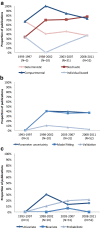Modelling the transmission of healthcare associated infections: a systematic review
- PMID: 23809195
- PMCID: PMC3701468
- DOI: 10.1186/1471-2334-13-294
Modelling the transmission of healthcare associated infections: a systematic review
Abstract
Background: Dynamic transmission models are increasingly being used to improve our understanding of the epidemiology of healthcare-associated infections (HCAI). However, there has been no recent comprehensive review of this emerging field. This paper summarises how mathematical models have informed the field of HCAI and how methods have developed over time.
Methods: MEDLINE, EMBASE, Scopus, CINAHL plus and Global Health databases were systematically searched for dynamic mathematical models of HCAI transmission and/or the dynamics of antimicrobial resistance in healthcare settings.
Results: In total, 96 papers met the eligibility criteria. The main research themes considered were evaluation of infection control effectiveness (64%), variability in transmission routes (7%), the impact of movement patterns between healthcare institutes (5%), the development of antimicrobial resistance (3%), and strain competitiveness or co-colonisation with different strains (3%). Methicillin-resistant Staphylococcus aureus was the most commonly modelled HCAI (34%), followed by vancomycin resistant enterococci (16%). Other common HCAIs, e.g. Clostridum difficile, were rarely investigated (3%). Very few models have been published on HCAI from low or middle-income countries.The first HCAI model has looked at antimicrobial resistance in hospital settings using compartmental deterministic approaches. Stochastic models (which include the role of chance in the transmission process) are becoming increasingly common. Model calibration (inference of unknown parameters by fitting models to data) and sensitivity analysis are comparatively uncommon, occurring in 35% and 36% of studies respectively, but their application is increasing. Only 5% of models compared their predictions to external data.
Conclusions: Transmission models have been used to understand complex systems and to predict the impact of control policies. Methods have generally improved, with an increased use of stochastic models, and more advanced methods for formal model fitting and sensitivity analyses. Insights gained from these models could be broadened to a wider range of pathogens and settings. Improvements in the availability of data and statistical methods could enhance the predictive ability of models.
Figures






References
-
- European Centre of Diseases Control. Annual Epidemiological Report on Communicable Diseases in Europe 2008: Report on the State of Communicable Diseases in the EU and EEA/EFTA Countries. Stockholm: European Centre of Disease Control; 2008.
-
- MRSA and MSSA bacteraemia and C. difficile infection mandatory data (official statistics) http://www.hpa.org.uk/Topics/InfectiousDiseases/InfectionsAZ/HCAI/Latest...
-
- Walker AS, Eyre DW, Wyllie DH, Dingle KE, Harding RM, O’Connor L, Griffiths D, Vaughan A, Finney J, Wilcox MH, Crook DW, Peto TE A. Characterisation of clostridium difficile hospital ward-based transmission using extensive epidemiological data and molecular typing. PLoS Med. 2012;9:e1001172. doi: 10.1371/journal.pmed.1001172. - DOI - PMC - PubMed
-
- Hensgens MPM, Keessen EC, Squire MM, Riley TV, Koene MGJ, de Boer E, Lipman LJ A, Kuijper EJ. Clostridium difficile infection in the community: a zoonotic disease? Clin Microbiol Infect. 2012;67:1–11. - PubMed
Publication types
MeSH terms
LinkOut - more resources
Full Text Sources
Other Literature Sources
Miscellaneous

